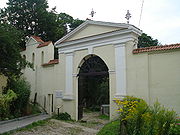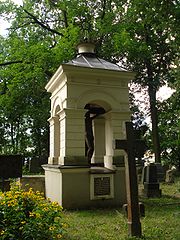
Bernardine Cemetery
Encyclopedia


Vilnius
Vilnius is the capital of Lithuania, and its largest city, with a population of 560,190 as of 2010. It is the seat of the Vilnius city municipality and of the Vilnius district municipality. It is also the capital of Vilnius County...
, Lithuania
Lithuania
Lithuania , officially the Republic of Lithuania is a country in Northern Europe, the biggest of the three Baltic states. It is situated along the southeastern shore of the Baltic Sea, whereby to the west lie Sweden and Denmark...
. It covers about 38,000 square metres and has an estimated 14,000 burial sites. It was established in 1810 by the Bernardine monks of the Church
Church Body
A local church is a Christian religious organization that meets in a particular location. Many are formally organized, with constitutions and by-laws, maintain offices, are served by pastors or lay leaders, and, in nations where this is permissible, often seek seek non-profit corporate status...
of St. Francis of Assisi, just east of the city center in the Užupis
Užupis
Užupis is a neighborhood in Vilnius, the capital of Lithuania, largely located in Vilnius' old town, a UNESCO World Heritage Site. Užupis means "on the other side of the river" in the Lithuanian language and refers to the Vilnia River. The name Vilnius was derived from the Vilnia...
district, and is situated on an embankment of the Vilnia river
Vilnia River
Vilnia is a river in Lithuania. Its source is near the village of Vindžiūnai, 5 km south of Šumskas, at the Lithuanian-Belarusian border. The Vilnia is 79.6 km long and its basin covers 624 sq. km...
. Its development was a consequence of Tsarist authorities of the Russian Empire
Russian Empire
The Russian Empire was a state that existed from 1721 until the Russian Revolution of 1917. It was the successor to the Tsardom of Russia and the predecessor of the Soviet Union...
prohibiting burying the dead near churches. The residents of Vilnius moved the cemetery to what was then the outskirts of the city.
The Columbaria
Columbarium
A columbarium is a place for the respectful and usually public storage of cinerary urns . The term comes from the Latin columba and originally referred to compartmentalized housing for doves and pigeons .The Columbarium of Pomponius Hylas is a particularly fine ancient Roman example, rich in...
were built on the east and west sides of the cemetery. The cemetery was expanded in 1860. After the Second World War the cemetery was abandoned for the most part and began to deteriorate. It was closed in the 1970s and since then until recently it had remained almost unchanged. Many of the oldest graves had sunk into the ground and became covered in moss
Moss
Mosses are small, soft plants that are typically 1–10 cm tall, though some species are much larger. They commonly grow close together in clumps or mats in damp or shady locations. They do not have flowers or seeds, and their simple leaves cover the thin wiry stems...
. The eastern columbarium had almost entirely disappeared. Restoration and reconstruction of its buildings and monuments, including the western columbarium, began in the late 1990s.
Restoration work
Beginning in 2005, on the initiative of the Adam MickiewiczAdam Mickiewicz
Adam Bernard Mickiewicz ) was a Polish poet, publisher and political writer of the Romantic period. One of the primary representatives of the Polish Romanticism era, a national poet of Poland, he is seen as one of Poland's Three Bards and the greatest poet in all of Polish literature...
Polish-Lithuanian foundation together with the Council for the Protection of Struggle and Martyrdom Sites
Council for the Protection of Struggle and Martyrdom Sites
The Council for the Protection of Struggle and Martyrdom Sites is a Polish government body charged with the preservation of historical sites associated with the Polish nation...
(one of the main initiators of the project was Andrzej Przewoźnik
Andrzej Przewoźnik
Andrzej Przewoźnik was a Polish historian, Secretary of the Council for the Protection of Struggle and Martyrdom Sites....
, a Polish historian who died in the airplane crash in Smolensk in 2010
2010 Polish Air Force Tu-154 crash
The 2010 Polish Air Force Tu-154 crash occurred on 10 April 2010, when a Tupolev Tu-154M aircraft of the Polish Air Force crashed near the city of Smolensk, Russia, killing all 96 people on board...
), conservation work on the cemetery (known in Polish
Polish language
Polish is a language of the Lechitic subgroup of West Slavic languages, used throughout Poland and by Polish minorities in other countries...
as Cmentarz Bernardyński na Zarzeczu) commenced with the aim of restoring the necropolis for 2010, the two hundredth anniversary of the founding. The restoration work was funded by private donors as well as through a joint effort by the Polish and Lithuanian governments. More than a hundred historic tombstones have been renovated, most of them those of Polish and Lithuanian participants of the January Uprising
January Uprising
The January Uprising was an uprising in the former Polish-Lithuanian Commonwealth against the Russian Empire...
, Home Army soldiers and the past faculty of the Stefan Batory University. Further renovations are planned.
Famous graves
Numerous famous scientists, painters and Vilnius UniversityVilnius University
Vilnius University is the oldest university in the Baltic states and one of the oldest in Eastern Europe. It is also the largest university in Lithuania....
, intellectuals, professors and other renowned people are buried there including:
- Helena Dzierżyńska (1849–1896), Felix Dzerzhinsky's mother
- Stanisław Fleury (1861–1915), Polish artist and photographer
- Stanisław Bonifacy Jundziłł (1761–1847), Polish botanist and florist, professor of Vilnius University and head of the Botanical GardenBotanical Garden of Vilnius UniversityBotanical Garden of Vilnius University is a botanical garden situated in Vilnius, Lithuania.-History:The garden was established by professor J. E. Giliber of Vilnius University in 1781. In 1832 the Vilnius University and Botanical Garden were closed. In 1919, the Botanical Garden was started in...
- Kazimieras Kairiūkštis (1886–1918), engineer
- Vytautas Kairiūkštis (1890–1961), Lithuanian painter
- Włodzimierz Mazurkiewicz – Polish pilot and engineer
- Franciszek Narwojsz – Polish matematician and engineer
- Valdas Herkus Neimantas (1963–2006), the main designer of Užupis Republic
- Zachariasz Niemczewski – Polish professor of mathematics
- Antanas Ramonas (1946–1993), writer
- Stanisław Rosołowski (1797–1855), Polish writer and doctor
- Bolesław Rusiecki – Polish painter
- Kanuty Rusiecki – Polish painter
- Ludwik Sobolewski (1791–1830), Polish writer and historian, prefect of the Vilnius University Library
- Józef Szeliga-Bieliński (1848–1926), Polish physician and historian, the first honorary professor of Stefan Batory University

